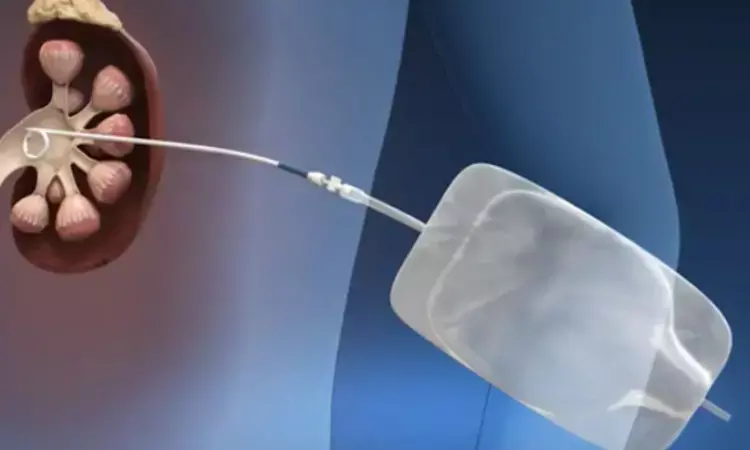- Home
- Medical news & Guidelines
- Anesthesiology
- Cardiology and CTVS
- Critical Care
- Dentistry
- Dermatology
- Diabetes and Endocrinology
- ENT
- Gastroenterology
- Medicine
- Nephrology
- Neurology
- Obstretics-Gynaecology
- Oncology
- Ophthalmology
- Orthopaedics
- Pediatrics-Neonatology
- Psychiatry
- Pulmonology
- Radiology
- Surgery
- Urology
- Laboratory Medicine
- Diet
- Nursing
- Paramedical
- Physiotherapy
- Health news
- Fact Check
- Bone Health Fact Check
- Brain Health Fact Check
- Cancer Related Fact Check
- Child Care Fact Check
- Dental and oral health fact check
- Diabetes and metabolic health fact check
- Diet and Nutrition Fact Check
- Eye and ENT Care Fact Check
- Fitness fact check
- Gut health fact check
- Heart health fact check
- Kidney health fact check
- Medical education fact check
- Men's health fact check
- Respiratory fact check
- Skin and hair care fact check
- Vaccine and Immunization fact check
- Women's health fact check
- AYUSH
- State News
- Andaman and Nicobar Islands
- Andhra Pradesh
- Arunachal Pradesh
- Assam
- Bihar
- Chandigarh
- Chattisgarh
- Dadra and Nagar Haveli
- Daman and Diu
- Delhi
- Goa
- Gujarat
- Haryana
- Himachal Pradesh
- Jammu & Kashmir
- Jharkhand
- Karnataka
- Kerala
- Ladakh
- Lakshadweep
- Madhya Pradesh
- Maharashtra
- Manipur
- Meghalaya
- Mizoram
- Nagaland
- Odisha
- Puducherry
- Punjab
- Rajasthan
- Sikkim
- Tamil Nadu
- Telangana
- Tripura
- Uttar Pradesh
- Uttrakhand
- West Bengal
- Medical Education
- Industry
Vacuum-Assisted Mini-PCNL Cuts Infection Risk in Low-Risk Kidney Stone Patients: Study

Italy: A recent single-center study published in the World Journal of Urology has highlighted the potential benefits of vacuum-assisted mini-percutaneous nephrolithotomy (vamPCNL) over the standard vacuum-cleaner mini-percutaneous nephrolithotomy (vcmPCNL) in reducing infectious complications in patients with low risk factors. The research, conducted by Marco Nizzardo and colleagues from the Department of Urology, Fondazione IRCCS Ca’ Granda–Ospedale Maggiore Policlinico, Milan, Italy, focused on evaluating outcomes in individuals undergoing these minimally invasive procedures for kidney stones.
The retrospective analysis included data from 229 patients treated between January 2016 and September 2024. All participants met the criteria for low risk, which included a negative preoperative urine culture, absence of prior urinary tract infections or immune disorders, no indwelling stent or catheter before surgery, and undergoing a single-stage procedure. Patient demographics, stone characteristics, and operative parameters were compared between the two surgical techniques to determine their impact on postoperative infection rates.
Based on the study, the researchers reported the following findings:
- 177 patients (77.2%) underwent vamPCNL, while 52 patients (22.8%) received vcmPCNL.
- The overall median age of the participants was 56 years.
- The median stone volume recorded was 1.7 cm³.
- Infectious complications occurred in 23 patients (10%) despite the low-risk profile.
- Infection rates were significantly higher in vcmPCNL compared to vamPCNL (19.6% vs. 6.8%).
- Patients with postoperative infections generally had larger stone volumes and multiple stones.
- Longer operative times were associated with cases that developed infections.
- Female patients were more likely to experience infectious complications compared to males.
- vcmPCNL was found to independently increase the risk of infections by more than four times after adjusting for stone size.
- The female gender independently increased the likelihood of infection by approximately 2.6 times.
- Another noteworthy finding was the association between infectious complications and longer hospital stays.
- Patients who experienced postoperative infections had extended lengths of stay compared to those without complications, indicating an added clinical and economic burden.
The authors emphasize that although both vamPCNL and vcmPCNL are effective minimally invasive techniques for managing kidney stones, the study suggests a clear advantage of vacuum-assisted approaches in minimizing infection risks in low-risk individuals. By facilitating continuous suction during stone removal, vamPCNL may help reduce bacterial load and maintain a cleaner surgical field, which could account for its lower complication rate.
The researchers conclude that in low-risk patients, approximately one in ten may still develop infectious complications following mini-percutaneous nephrolithotomy. However, selecting vamPCNL over the conventional vacuum-cleaner technique appears to significantly lower this risk. They highlight the importance of considering stone burden, operative time, and patient gender when assessing infection risk and planning the surgical approach.
"Further prospective and multicenter studies are needed to validate these findings and explore whether the benefits of vamPCNL extend to higher-risk populations. The study provides valuable evidence supporting the role of vacuum-assisted techniques in optimizing safety outcomes in kidney stone surgery," the authors wrote.
Reference:
Nizzardo, M., Li Puma, A., Graps, G. et al. Vacuum-assisted mini-percutaneous nephrolithotomy is associated with lower rates of infectious complications compared to standard procedures in low-risk patients: a single-center experience. World J Urol 43, 457 (2025). https://doi.org/10.1007/s00345-025-05783-2
Dr Kamal Kant Kohli-MBBS, DTCD- a chest specialist with more than 30 years of practice and a flair for writing clinical articles, Dr Kamal Kant Kohli joined Medical Dialogues as a Chief Editor of Medical News. Besides writing articles, as an editor, he proofreads and verifies all the medical content published on Medical Dialogues including those coming from journals, studies,medical conferences,guidelines etc. Email: drkohli@medicaldialogues.in. Contact no. 011-43720751


